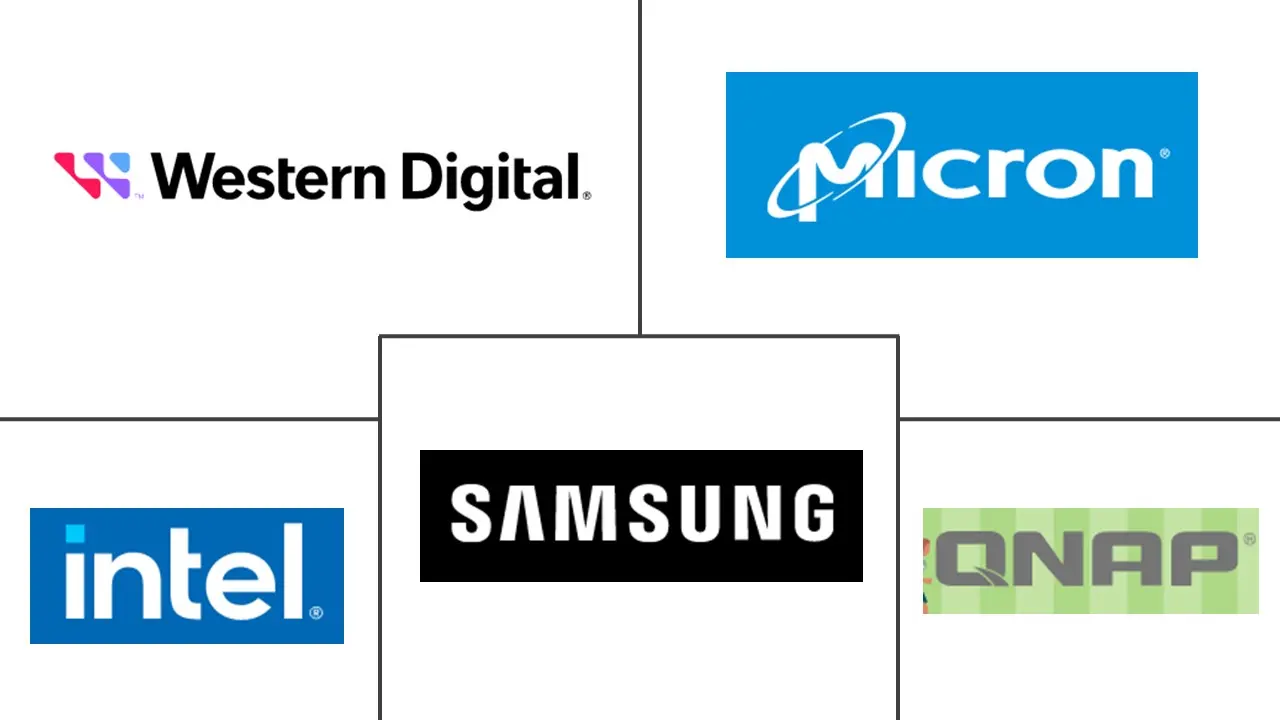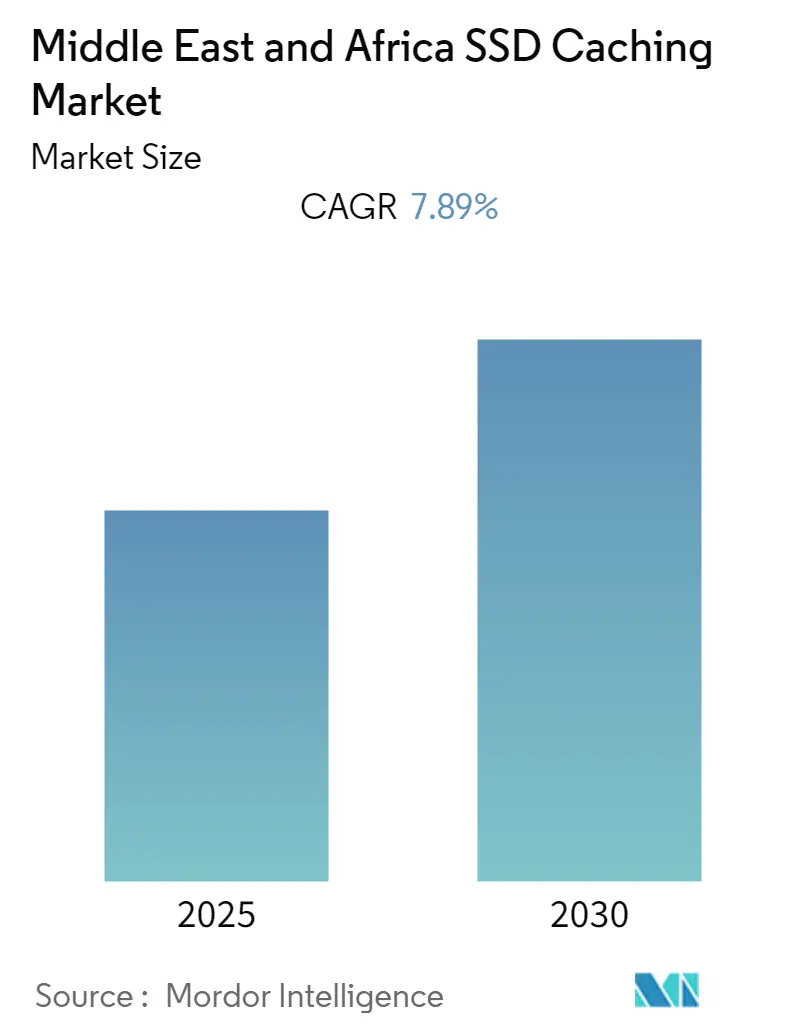
Middle East and Africa SSD Caching Market Analysis by Mordor Intelligence
The Middle East and Africa SSD Caching Market is expected to register a CAGR of 7.89% during the forecast period.
- SSD Caching requires a combination of an SSD drive and associated software to work properly. Because SSD drives are expensive, they are used with regular hard drives to improve performance efficiency. The market is constantly expanding, with businesses implementing these solutions to save costs and enhance productivity. Organizations should examine massive data sets obtained from diverse data sources. SSD solutions simplify the process without requiring a large investment in high-powered drives and solutions.
- SSDs based on NAND flash memory is ideal for Big Data applications because they provide ultra-fast storage performance and a quick return on investment. SSDs can be used as host cache, network cache, all-SSD storage arrays, or as the SSD layer in hybrid storage arrays.
- According to OECD, the external financial flows to African economies and its population are increasing. In terms of employment, growth has been increasing, but the rate of job creation remains slow. According to the Internet World Stats, as of December last year, the number of internet users in Africa is 601.32 million, and 205.02 million in the Middle East.
- SSD drives are costly; hence a combination of them needs to be used with traditional hard drives to enhance performance efficiency. The market is still growing, and many enterprises are deploying these solutions to cut costs and improve efficiency. These enterprises must analyze huge data sets coming from various data sources. SSD solutions simplify the task without investing too much in high-powered drives and solutions.
- The outbreak of COVID-19 has had a significant effect on the market. The raw materials supply is affected. Hence the value chain is disrupted, causing an inflationary risk on products. The supply chain gap is projected to narrow as the electronics supply chains in China and South Korea recover after the pandemic.
Middle East and Africa SSD Caching Market Trends and Insights
Enterprise Storage Expected to Hold Major Share
- Servers are typically configured with banks of hard disc drives (HDD) or connected to storage area networks (SANs), which are large banks of hard drives. In the business storage network, improvements in server technology caused an I/O performance gap. SSD-based caching closes the I/O performance gap by lowering I/O latency and enhancing IOPS performance. Server-based caching does not necessitate storage array upgrades or the installation of any other appliances in the data path of important networks. SSD caching in servers effectively reduces the requirement for storage networks and arrays by servicing large percentages of the I/O demand of important servers at the network edge. This decrease in demand improves storage performance for other associated servers, potentially extending the storage infrastructure's useful life.
- In a corporate environment, SSD caching stores previously requested data as it passes through the network, allowing it to be retrieved fast when needed. Placing previously requested material in temporary storage lessens the demand on an enterprise's bandwidth and speeds up access to the most up-to-date information. Enterprise SSDs store data permanently or momentarily cache data in nonvolatile semiconductor memory. NAND flash memory is used in these SSDs, providing better performance and less power than spinning HDDs. SSD caching is becoming more important as the demand for computing speed rises across various industries in the MEA region. As a result, many companies have entered the SSD cache market. This resulted in a decrease in the cost of SSD caches.
- Data-center applications in various businesses are processing an expanding volume of data sets. The page cache's caching impact is hampered by its low capacity. Compared to hard discs and DRAM, emerging flash-based SSDs provide lower latency and costs. As a result, SSD-based caching is commonly used in data centers. According to the worldwide cloud index, data center traffic has increased data storage requirements. Because of its high-performance features, the high-traffic data center will increase demand for SSD caching. SSD caching allows data centers and cloud computing environments to host more users and complete more transactions per second by accelerating input/output operations per second (IOPs) and reducing latency.
- Maintaining investments, on the other hand, is the most difficult task. Due to the pandemic, company and customer workloads have increased dramatically, necessitating a careful balance between protecting existing investments and buying the appropriate cloud storage to meet the increasing demand. Furthermore, organizations have faced additional problems upskilling their current workforces, as cloud adoption necessitates certain skills and knowledge to ensure effective migrations to new platforms.
- The rapid expansion of Internet-connected users and an expanding number of SMEs and cloud service suppliers has created tremendous growth opportunities across the region, where interconnection bandwidth is accelerating due to strong demand. According to Telecommunications Regulatory Authority (UAE), as of March this year, there were around 3.67 million broadband internet subscriptions in the United Arab Emirates.
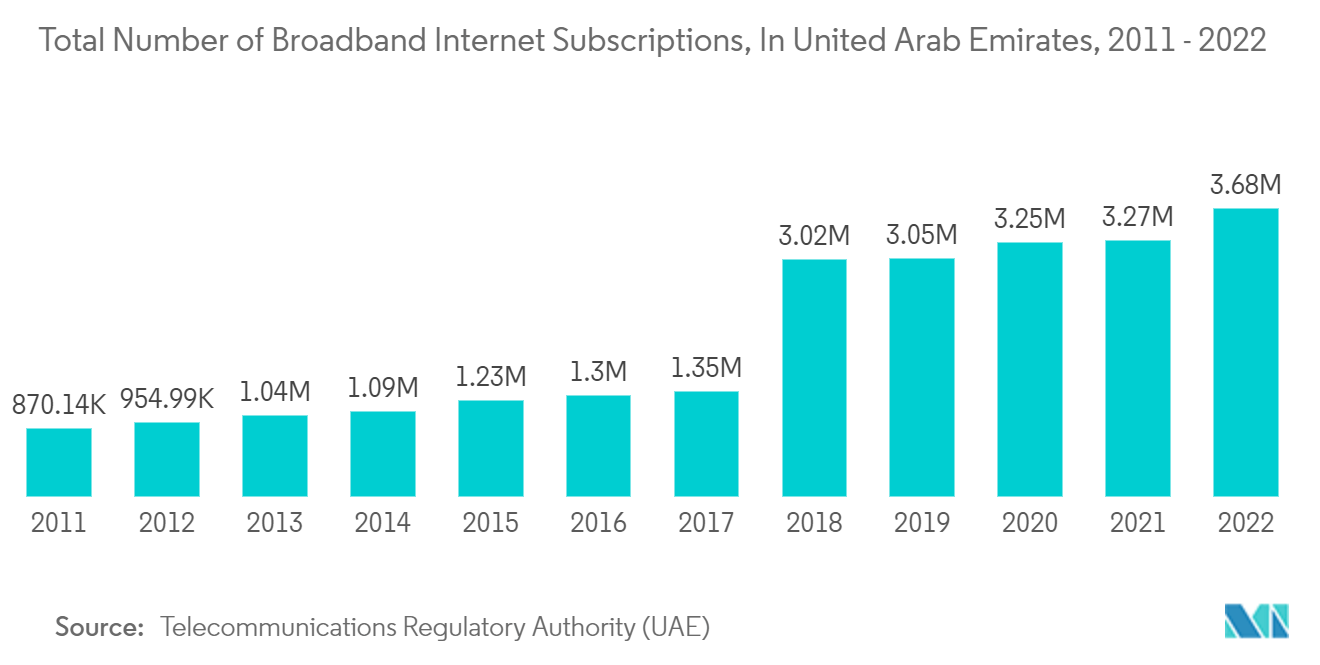
Demand for the Cloud Storage Driving the Market Growth
- Hybrid cloud technologies have reached a high level of maturity in the industry, allowing clients to operate workloads in a hybrid environment while guaranteeing that they are exploiting the cloud without disrupting business operations (e.g., AWS Outpost, Azure Stack & Google Anthos). Cloud platforms enabled new, complex business models and have been orchestrating more global-based integration networks in recent years. The deployment of storage solutions over the cloud offers greater convenience, as the service vendor is solely responsible for providing maximum uptime, data security, and periodic updates, thus, decreasing the total cost of ownership.
- The need to reduce latency by moving data closer to the customer and governmental and business regulations for data to be kept locally within different areas are projected to drive growth in cloud storage in the MEA region. Enterprises in the region installing complex cloud infrastructures want systems that can quickly store, retrieve, process, and analyze large amounts of business-critical data. As a result of this demand, many firms in the Middle East and Africa are switching from SATA-based SSDs to NVMe-based SSDs for primary storage. The latest NVMe SSDs include caching capabilities. The data center sector is rapidly expanding, with a greater emphasis on efficiency and maximum uptime.
- In addition, the cloud acts as a catalyst for IT transformation, providing the flexibility to combine the preferred clouds and existing on-premises infrastructure in the ratio best suited for the workload. According to Cisco Systems, This year, cloud traffic in the Middle East and Africa would amount to an estimated 304 exabytes.
- Furthermore, the rising focus on cost optimization and business agility has led to the expansion of cloud data centers. Also, cloud services adapt easily to the changing landscape to meet new requirements. This allows the client organization to focus on its core competency, which, in turn, results in its overall growth.
- With unstructured data expanding by more than 50% annually, managed service providers are looking at cloud storage as an upfront revenue opportunity. The greater need for storage control further augmented this. The foray into advanced technologies prompts companies to emphasize updating their storage system to match the competition. The hybrid cloud is one such trend that significantly boosts the market growth. However, security and the need for more network bandwidth for data transfer can challenge the development of the market.
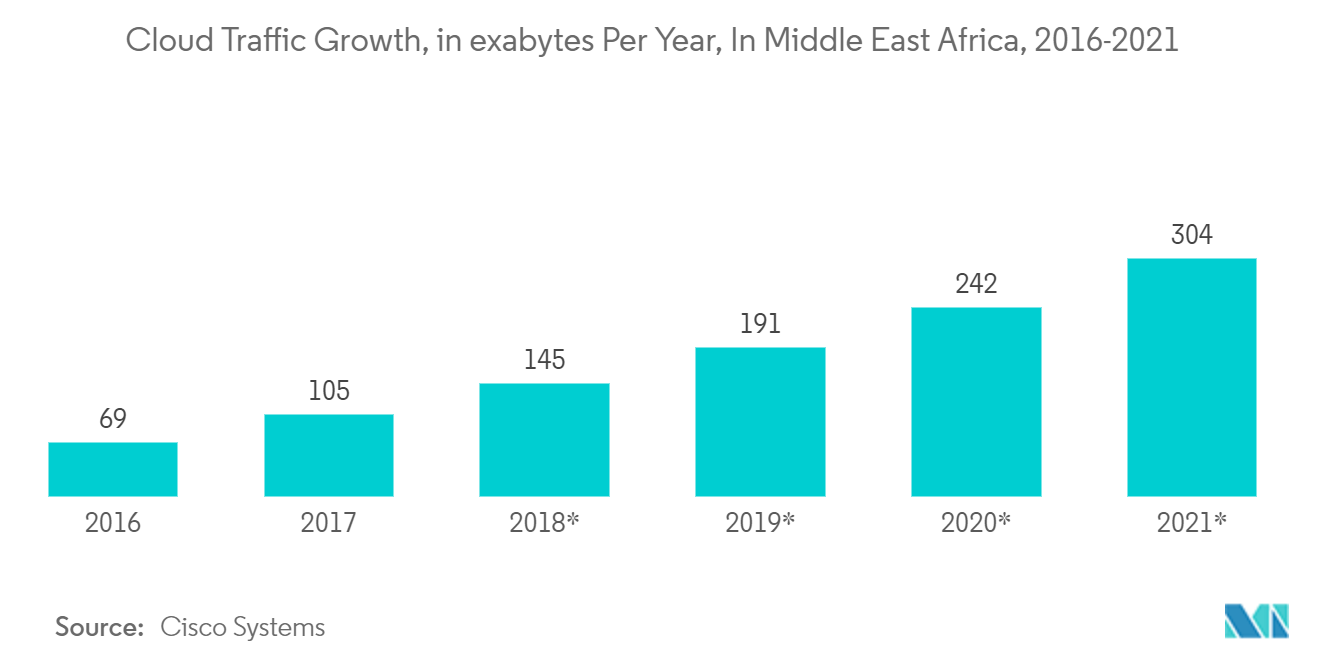
Competitive Landscape
The SSD Caching Market in the Middle East and Africa is consolidated with the presence of key players like Intel Corporation, Samsung Electronics Co. Ltd, Micron Technology Inc., Western Digital Corporation, and QNAP Systems Inc. Players in the market are adopting strategies such as partnerships, mergers, innovations, and acquisitions to enhance their product offerings and gain sustainable competitive advantage.
In November 2022: QNAP Systems, Inc., a computing, networking, and storage solution innovator, launched the high-performance TVS-hx74 QuTS hero NAS series, which includes the 4-bay TVS-h474, 6-bay TVS-h674, and 8-bay TVS-h874 models, all of which feature 12th Gen Intel, multi-core/multi-thread processors. The TVS-hx74, which runs the ZFS-based QuTS hero operating system, assures data integrity and enables inline data deduplication and compression, near-infinite snapshots, and real-time SnapSync. The dependable TVS-hx74 handles tough business difficulties in storage, backup, virtualization, and application servers with PCIe Gen 4 (up to twice the transmission speed of Gen 3) expandability, M.2 NVMe SSD caching, and 2.5GbE networking.
Middle East and Africa SSD Caching Industry Leaders
-
Intel Corporation
-
Samsung Electronics Co. Ltd
-
Micron Technology Inc
-
Western Digital Corporation
-
QNAP Systems Inc.
- *Disclaimer: Major Players sorted in no particular order
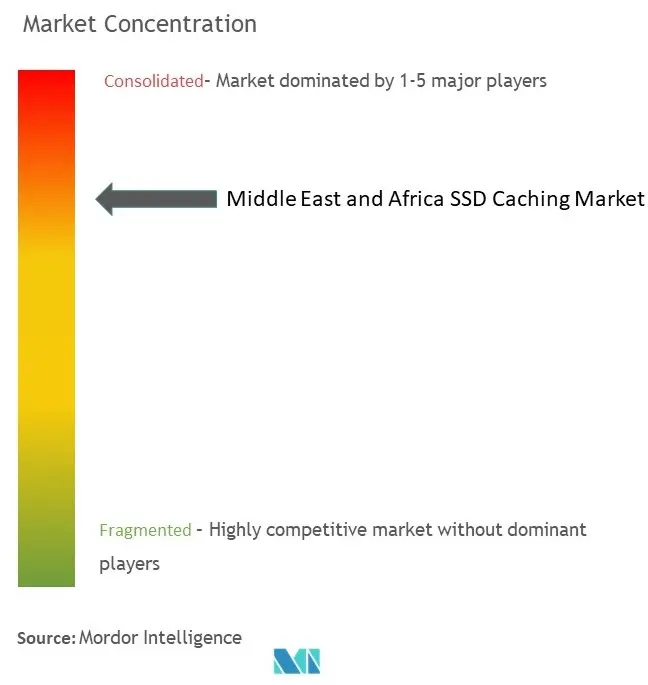
Recent Industry Developments
- October 2022: Lenovo launched ThinkSystem DM5000H a unified, hybrid storage system developed for midsize companies to deliver performance, simplicity, capacity, security, and high availability. ThinkSystem DM5000H, powered by ONTAP software, provides enterprise-class storage management capabilities with a wide range of host connectivity choices, customizable drive configurations, increased data management tools, and acceleration of read-centric workloads with onboard NVMe SSD caching.
- September 2022: Amazon Relational Database Service for Oracle supports the instance store for temporary tablespaces and the Database Smart Flash Cache (flash cache) for M5d and R5d instances. M5d and R5d instances are ideal for applications that require high-speed, low-latency local storage, such as those that require temporary data storage for scratch space, temporary files, and caches.
Middle East and Africa SSD Caching Market Report Scope
SSD caching, also known as flash caching, is the temporary storage of data on NAND flash memory chips in a solid-state drive (SSD) to allow for a faster response to data requests. In an enterprise IT setting, the purpose of SSD read caching is to store previously requested data as it passes through the network so that it can be retrieved rapidly when needed. Placing previously requested information in temporary storage or cache decreases bandwidth usage and speeds up access to the most active data. Caching data on SSDs can be more cost-effective than storing data on top-tier flash storage. SSD write caching aims to hold data briefly until slower persistent storage media has enough resources to complete the writing process.
The Middle East and Africa SSD Caching market are segmented by Application (Enterprise Storage, Personal Storage).
For each segment, the market sizing and forecasts have been provided on the basis of value (in USD million) and volume (in metric tons).
| Enterprise Storage |
| Personal Storage |
| Application | Enterprise Storage |
| Personal Storage |
Key Questions Answered in the Report
What is the current Middle East and Africa SSD Caching Market size?
The Middle East and Africa SSD Caching Market is projected to register a CAGR of 7.89% during the forecast period (2025-2030)
Who are the key players in Middle East and Africa SSD Caching Market?
Intel Corporation, Samsung Electronics Co. Ltd, Micron Technology Inc, Western Digital Corporation and QNAP Systems Inc. are the major companies operating in the Middle East and Africa SSD Caching Market.
What years does this Middle East and Africa SSD Caching Market cover?
The report covers the Middle East and Africa SSD Caching Market historical market size for years: 2019, 2020, 2021, 2022, 2023 and 2024. The report also forecasts the Middle East and Africa SSD Caching Market size for years: 2025, 2026, 2027, 2028, 2029 and 2030.
Page last updated on:
Middle East and Africa SSD Caching Market Report
Statistics for the 2025 Middle East and Africa SSD Caching market share, size and revenue growth rate, created by Mordor Intelligence™ Industry Reports. Middle East and Africa SSD Caching analysis includes a market forecast outlook for 2025 to 2030 and historical overview. Get a sample of this industry analysis as a free report PDF download.
